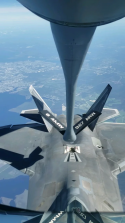On the other hand, virtually no space is left empty inside a modern 5th generation fighter - even if you are adding volume for primarily aerodynamic reasons, you will be taking advantage of it for other purposes.
Since its fuselage packaging is virtually the same, the F-22 offers a reasonable clue on the J-20 fuel tank configuration, and that indicates there should indeed be a tank there. There's another reason fuel capacity is the most likely use of the additional volume: fuel is the only component that is "malleable" in shape and scales continuously. As you say, electronics have a limited ability to conform to an aerodynamically determined shape, and you'd have to wonder what the original J-20 was even lacking in the avionics department. Is a seventh MAWS sensor (for instance) really sensible, when the six on the base model already provide full spherical coverage?
The one scenario where I can see the volume being used for electronics is if it is occupied by boxes displaced from elsewhere on the airframe by a new piece of (non-avionics) equipment. Say, this new variant gets a gun, and something which originally sat where the gun now is located was moved into the spine.
Like fuel, more weapons would obviously also be always welcome, but missile payload scales in discrete increments and has a fixed geometry. Additionally, the spine adds the most volume well forward of the weapons bay, approximately above the nose gear well. To gain meaningful bay depth, you'd have to move the intake ducts (which curve inward to almost meet on the centreline over the bay) and I just don't see enough new volume in that place for this to happen.
TL,DR: the spine is not going to be empty, and fuel is by far the most likely thing to occupy the additional space.






